

TOO often the decline in religious observance or demographic changes in neighborhoods have been documented here with churches and synagogues demolished in favor of uninspiring brick and glass residential towers. But if one knows where to look, there are examples of creative reuses where houses of worship were converted to other religions, maintaining their stated purpose. In the Hollis neighborhood of Queens, there are a handful of such examples.

Masjid Eesa ibn Maryan at 90-20 191st Street has the appropriate name as its building was previously the Evangelical Lutheran Church of the Holy Trinity. This Christian denomination originated in Germany and the pre-grid name of this street was Palatina Avenue, after a region in the old country. It had an organ that was destroyed by an arsonist in 1974. The church was sold to the mosque in 2010. After the crucifixes and pews were removed, prayer rugs were laid out, stained glass windows were given non-objective panels, sinks were installed for washing hands and feet, the pulpit was moved to the center as the minbar, and curtains separated the men’s and women’s sections.
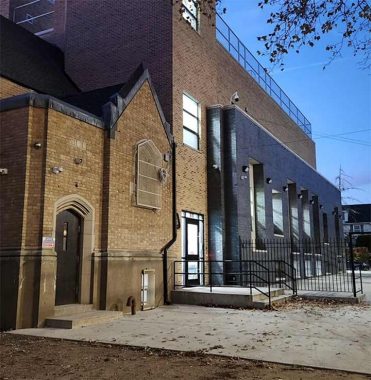
The church’s school next door was expanded and reopened as FKAD Institute, a Muslim learning center whose acronym stands for Foundation for Knowledge and Development. Eesa, often spelled as Issa, is the Arabic name for Jesus, who is regarded as a prophet by Muslims, but not in the trinitarian form and they do not celebrate Christmas and Easter.
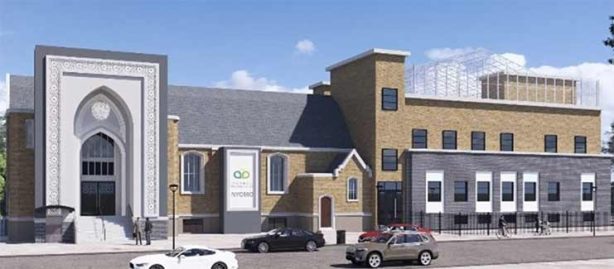
Admittedly, it is a very old building and the mosque is raising money to reconstruct it. Seeking a design that is familiar to Muslims, the plan seeks to transform the interior by hiding the wooden rafters and windows, and install a pointed archway at its entrance. Like the building’s previous religious occupant, this mosque has a missionary purpose, welcoming converts and visitors.

Across the street from this mosque is P.S. 35 Nathaniel Woodhull School, a 1920s building designed by CBJ Snyder that is identical to my alma mater PS 139 in Rego Park. As its student body grew, the school received an east wing at the turn of the millennium, and a west wing in 2015. The school’s namesake was a fighter in the American Revolution who died from wounds sustained in the Battle of Brooklyn. A nearby street in Hollis and an avenue in Brooklyn also commemorate this hero. As the school was covered with scaffolding during my visit, here’s a Google Street View of the building with its historic cannon in 2022.
During the Revolutionary War, General Nathan Woodhull was captured by the British at the Increase Carpenter tavern in 1776; according to legend, when the Brits ordered him to proclaim “God Save the King” he instead said, “God save us all” and earned a sword bludgeoning, for which his arm was later amputated. He was sent to a prison ship in Gravesend Bay, but a more sympathetic British official had him transferred to onshore house arrest, but he died later in the year.
However:
[A] different story emerged in 1951 when The New York Times ran a front-page article in which researcher W.H.W. Sabine doubted the compelling exchange. Sabine cited a dusty scrapbook with Woodhull’s own account of the capture – apparently given to a lieutenant who was with him in a prison camp when he died. Woodhull supposedly said that he surrendered his sword to – and was then struck by – an American Tory, loyal to the British, named Capt. Oliver DeLancey. Whether Woodhull was fatally struck while defending himself or after surrendering also became a point of contention. Experts even question his memorable quote. [NY Daily News]
The cannon was placed in 1905 and turns up on many postcards produced in the early 20th Century; but its origin is somewhat mysterious.
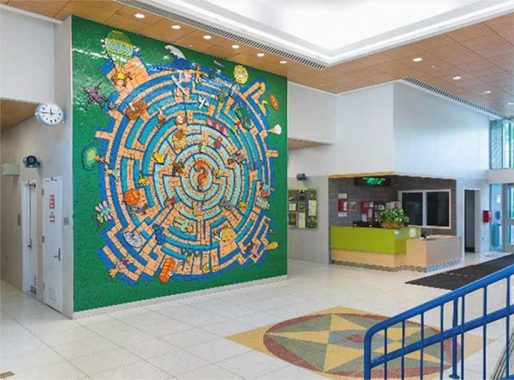
The latest expansion of this school in 2015 received a public art piece titled Mouse Maze by Matthew Thurber. It is among hundreds of such works installed in city buildings under the Percent for Art law.
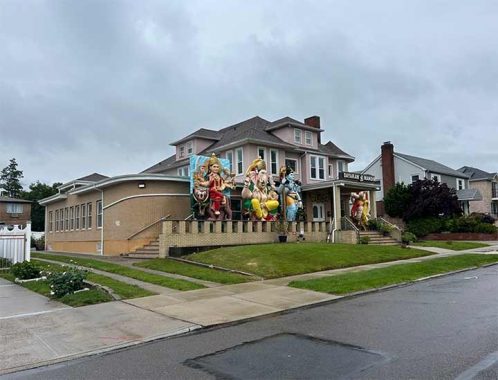
Darayam Mandir at 88-40 192nd Street is a former suburban mansion that was previously the India Christian Assembly but in 2018 became a Hindu temple, with statues of its gods installed in front of the building alongside prayer flags. As the temple grows in membership, this house will likely also experience a renovation to give it the appearance of an Indian temple. Prior to the number grid, 192nd Street was Hollis Park Boulevard, with its green median. Not to be confused with Hollis Court Boulevard that is still on the map.
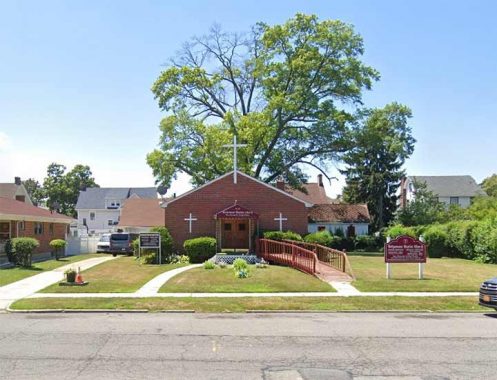
At 88-48 193rd Street, Gethsemane Baptist Church matches its single-story neighbors, built in 1961 as a Christian Science church. Founded by Mary Baker Eddy, it was one of many 19th century sects that emerged in this country. It is best known for emphasizing prayer over medicine for healing, reading rooms, and Christian Science Monitor, a respected news publication. This building was converted to Baptist in 1983.
Gethsemane comes from the Aramaic and Hebrew terms for oil press, indicating the olive orchard in Jerusalem where Jesus was arrested by Roman authorities.
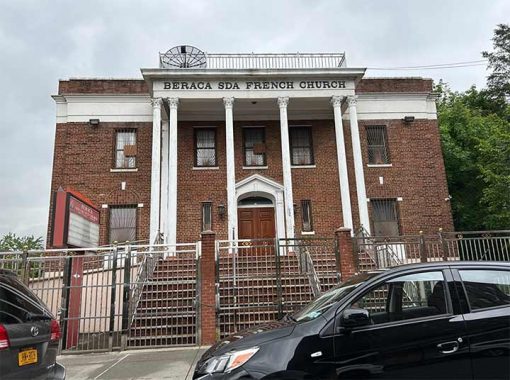
Beraca Seventh-day Adventist French Church at 91-19 191st Street took over a former Masonic Temple in 1988. Seventh-Day Adventism was also founded in this country in the 19th century. The Haitian congregation’s name is a transliteration of the Hebrew word for blessing. The initial occupants were the Freemasons, a centuries-old international fraternal order famous for its rituals, symbols, and secrecy. Prior to their building on 193rd Street, the local Christian Science church also prayed in this Masonic Temple.
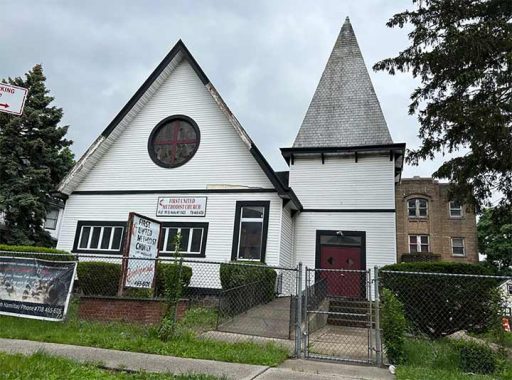
Next door to the Adventists is the First United Methodist Church, which regards Jesus as human but also the son of God. This denomination originated in England in the 18th century, focusing on the personal relationship with God, social services, and lay leadership. American Methodism is regarded as a “mainline” Protestant denomination, along with the Episcopals, Evangelical Lutherans, Baptists, and Presbyterians. They are theologically liberal, focused on social justice, and personal salvation, in contrast to the socially and doctrinally conservative Catholic, Orthodox churches, and evangelical churches.
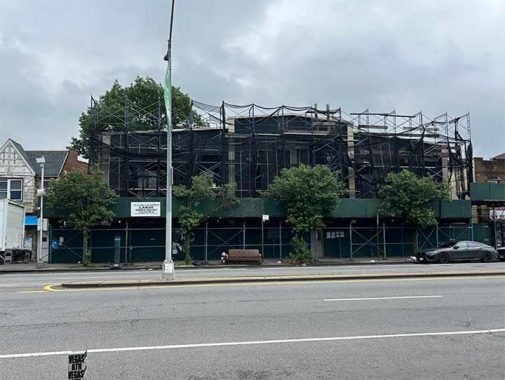
There is one religious building in Hollis that is no longer used for such purposes. Throughout the city, many former theaters were purchased by churches in appreciation of their sizable interiors, with Queens examples such as the former Valencia Theater in Jamaica preserved as a nondenominational “tabernacle” and Loew’s Woodside as a Catholic church. The former Hollis Theatre at 191-12 Jamaica Avenue became the Forbes Temple in 1978, but then became a commercial property in 2021. The property was covered in scaffolding during my visit.

192-07 Jamaica Avenue is the former Cox Funeral Home which became a church in 1978. A Spanish-speaking Pentecostal church preserves this building’s religious purpose. Next to it, another church! Built in 2005, Dominion City Assembly of God presently led by Nigerian-born pastor Michael Ezuruonye. In the past decade, this storefront church twice changed names, as Christ Peace Ministries, and Open Heavens Ministries, also led by West African pastors. The largest West African communities live in western Bronx and Harlem, with smaller groups on the north shore of Staten Island, and eastern Queens. Assemblies of God is also a denomination that began in this country.

The Roman Catholic Church for Hollis is the Shrine Church of Saint Gerard Majella, named in honor of the patron saint of expectant mothers. Born in 18th century Italy, the young journeyman wanted to be a Capuchin priest. Rejected on account of his poor health, he nevertheless lived a life of poverty, celibacy, and prayer. He is credited with expectant mothers coming to term. Built in 1923, the former parochial school has a collegiate gothic style similar to the nearby public school. The building is presently shared by the church and the Cambria Heights Academy, a public school. The concrete crucifix on the building was replaced with bricks as part of the transformation, but here its location is obvious.

New Canaan Pentecostal Church has the corner of Jamaica Avenue and 190th Street, a storefront for the denomination best known for promoting a “Spirit-filled and empowered life” that involves charismatic pastors, plenty of singing, and feeling the Holy Spirit. It also was conceived in America as an outgrowth of Methodism.
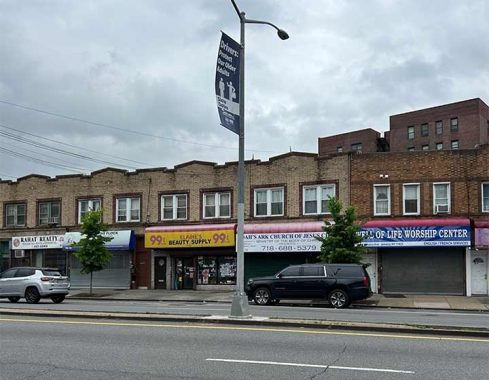
This block alone has seven more storefront churches! Some have been paying rent here for many years and others appeared here recently. I cannot explain why there are so many little churches here, why they aren’t united, and the nuances in theology that distinguish them from each other.
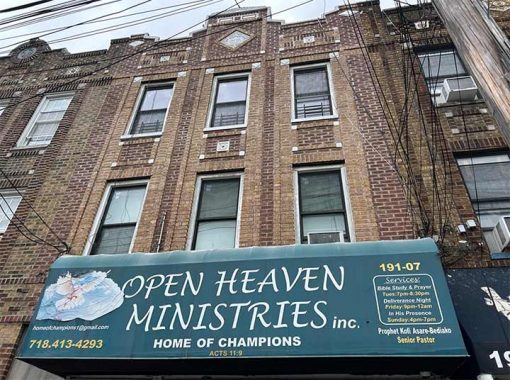
A quotation from the New Testament’s Book of Acts appears on one awning. This quote is among those that separate Christianity from Judaism: “Do not call anything impure that God has made clean,” indicating permission for Peter to eat non-kosher food in the home of uncircumcised men.
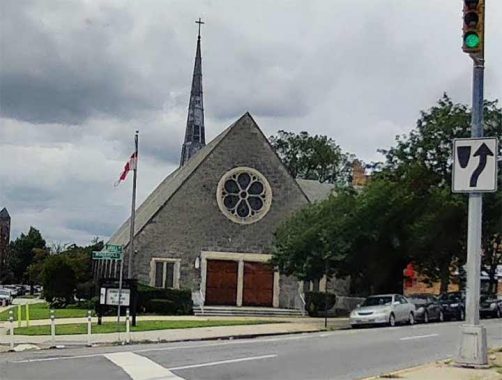
The Episcopal Church is the American branch of the global Anglican communion, established after this country declared independence. St Gabriel Episcopal Church is named after the biblical archangel who is also recognized by Catholics as a saint. Kevin walked this stretch of Jamaica Avenue in 2011, and explained the neighborhood in 2023, noting St. Gabriel’s on his way.
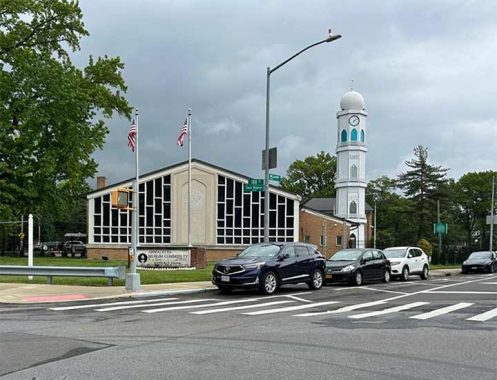
Three more examples of transformed sanctuaries nearby in Holliswood are 196-43 Foothill Avenue, a former Hindu temple turned mosque; 188-15 McLaughlin Avenue, a former Reform Jewish temple that became an Ahmadiyya mosque; and 86-71 Palo Alto Street, an Ahmadiyya mosque turned Sikh temple. Pictured here is the mosque on McLaughlin Avenue, with its recently installed minaret.
There are many more churches in this neighborhood situated in former houses and storefronts, but those described in this essay are unique for their transformative histories.
For an earlier example of a sanctuary converted, see this “synagogue to church to mosque” in Bed-Stuy!
Sergey Kadinsky is the author of Hidden Waters of New York City: A History and Guide to 101 Forgotten Lakes, Ponds, Creeks, and Streams in the Five Boroughs (2016, Countryman Press), adjunct history professor at Touro University and the webmaster of Hidden Waters Blog.
5/24/25

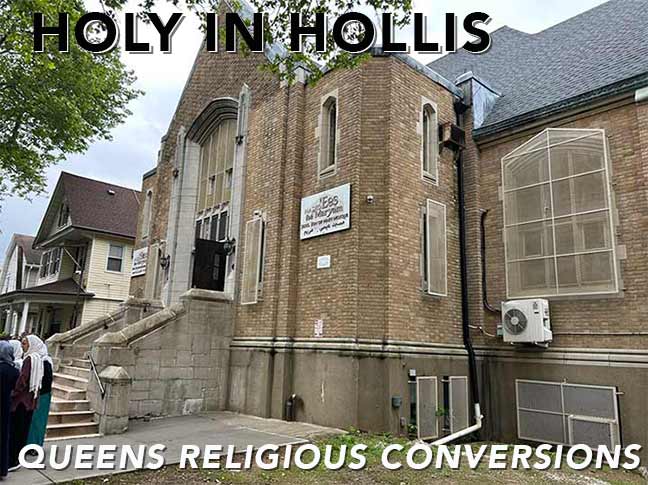
4 comments
In addition to the African churches, a growing proportion of Catholic priests in the US are from Africa.
This church on 67th Drive in Middle Village used to be a Synagogue.
https://www.google.com/maps/@40.711557,-73.8763516,3a,60.1y,13.38h,94.23t/data=!3m7!1e1!3m5!1seGXYyl6unszJG0Cv1dZ6uw!2e0!6shttps:%2F%2Fstreetviewpixels-pa.googleapis.com%2Fv1%2Fthumbnail%3Fcb_client%3Dmaps_sv.tactile%26w%3D900%26h%3D600%26pitch%3D-4.225667715645244%26panoid%3DeGXYyl6unszJG0Cv1dZ6uw%26yaw%3D13.378958204753552!7i16384!8i8192?entry=ttu&g_ep=EgoyMDI1MDUyMS4wIKXMDSoASAFQAw%3D%3D
Your article reflects the successive waves of immigrants and
the faiths they have carried to our shores.
I’m sure the neighbors of Darayam Mandir are just thrilled
to be next door to them